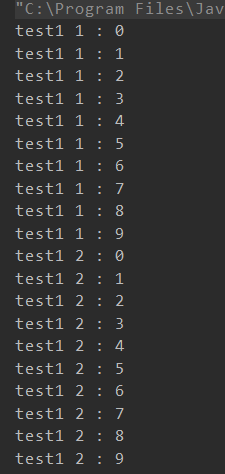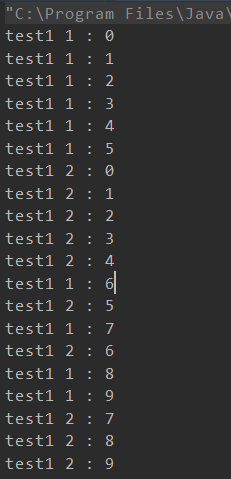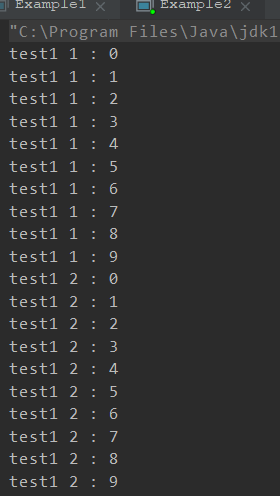Synchronized:可以在任意对象上加锁,而加锁的这段代码称为互斥区或临界区。
public class SynchronizedDemo {
/**
* 线程不安全示例
*/
class MyThread1 extends Thread{
private int count = 5;
@Override
public void run() {
count--;
System.out.println(this.currentThread().getName()+":"+count);
}
}
/**
* synchronized修饰后实现的线程安全
*/
class MyThread2 extends Thread{
private int count = 5;
@Override
public synchronized void run() {
count--;
System.out.println(this.currentThread().getName()+":"+count);
}
}
public static void test(Thread thread){
String threadName = "thread";
Thread[] threads = new Thread[5];
for (int i = 0; i < 5; i++) {
threads[i] = new Thread(thread,threadName+i);
}
for (Thread th : threads) {
th.start();
}
}
}
| 使用MyThread1创建对象调用test | 使用MyThread2创建对象调用test |
|---|---|
| thread0:3 thread3:2 thread2:3 thread1:1 thread4:0 | thread0:4 thread1:3 thread2:2 thread3:1 thread4:0 |
MyThread1和MyThread2的区别就是在run()方法上加上了synchronized修饰。
当多个线程访问run()方法时,如果使用了synchronized修饰,那么多个线程就会以排队的方式进行处理(cpu分配的先后顺序而定)。
synchronized作用于当前调用的对象
- synchronized修饰代码块
- synchronized修饰方法
演示代码:
public class Example1 {
//synchronized修饰代码块
public void test1(int j){
synchronized (this){
for (int i = 0; i < 10; i++) {
System.out.println("test1 "+ j+ " : "+i);
}
}
}
//synchronized修饰方法
public synchronized void test2(int j){
for (int i = 0; i < 10; i++) {
System.out.println("test2 "+ j+ " : "+i);
}
}
public static void main(String[] args) {
ExecutorService executorService = Executors.newCachedThreadPool();
Example1 example1 = new Example1();
Example1 example2 = new Example1();
executorService.execute(()->{
example1.test1(1);
});
executorService.execute(()->{
example1.test1(2);
});
}
}
当调用同一个对象时,输出结果为:

public static void main(String[] args) {
ExecutorService executorService = Executors.newCachedThreadPool();
Example1 example1 = new Example1();
Example1 example2 = new Example1();
executorService.execute(()->{
example1.test1(1);
});
executorService.execute(()->{
example2.test1(2);
});
}
当调用同不同对象时,输出结果为:

因为synchronized修饰代码块、方法时,作用域是当前对象,所以当是两个对象同时调用时,会出现两个对象方法交替执行的情况。
synchronized作用于所有对象
- synchronized修饰静态方法
- synchronized修饰类
public class Example2 {
//synchronized修饰类
public void test1(int j){
synchronized (Example2.class){
for (int i = 0; i < 10; i++) {
System.out.println("test1 "+ j+ " : "+i);
}
}
}
//synchronized修饰静态方法
public synchronized static void test2(int j){
for (int i = 0; i < 10; i++) {
System.out.println("test2 "+ j+ " : "+i);
}
}
public static void main(String[] args) {
ExecutorService executorService = Executors.newCachedThreadPool();
Example2 example1 = new Example2();
Example2 example2 = new Example2();
executorService.execute(()->{
example1.test1(1);
});
executorService.execute(()->{
example2.test1(2);
});
}
}
当synchronized修饰类、静态方法时,作用域是所有对象,所以当是两个对象同时调用时,这里就不会出现两个对象方法交替执行的情况。

注意:synchronized并不能被继承使用,因为synchronized非函数签名,因此无法被继承,所以无法保证子类调用同步.
synchronized可重入锁
当一个线程获得该对象的锁后,在该锁里执行代码的时候可以再次请求该对象的锁时,能再次获得该对象的锁。
即当线程请求一个由其他线程所持有的锁时,会阻塞;但是当它请求自身所持有的锁时,如果该锁是可重入锁,则会成功,否则会阻塞。
public class SynchronizedExample {
public synchronized void method1(){
System.out.println("method1...");
method2();
}
public synchronized void method2(){
System.out.println("method2...");
method3();
}
public synchronized void method3(){
System.out.println("method3...");
}
public static void main(String[] args) {
SynchronizedExample demo = new SynchronizedExample();
demo.method1();
}
}
存在的意义:防止死锁的产生。
synchronized和volatile的区别
volatile关键字是强制从公共堆栈中取得变量的值,而不是线程私有的数据栈中取得变量值。

- volatile是线程同步的轻量级实现,性能比synchronized要好,并且volatile只能作用于变量,而synchronized可以修饰类,方法,代码块。
- 多线程访问volatile不会发生阻塞,而synchronized会发生阻塞。
- volatile可以保证线程可见性,但不可以保证原子性;synchronized可以保证原子性,也可以间接保证可见性,因为,它会将工作内存与主内存中的数据做同步。
- volatile解决的是变量在多个线程之间的可见性,而synchronized解决的是多个线程间访问资源的同步性。
























 473
473











 被折叠的 条评论
为什么被折叠?
被折叠的 条评论
为什么被折叠?








